Abstract
Exposure of cells to phorbol 12-myristate 13-acetate (PMA) has been reported to result in resistance to the acute biological effects of insulin and an associated reduction in insulin-receptor tyrosine kinase activity. To investigate the relationship of insulin receptor autophosphorylation with a longer-term action of insulin the effect of PMA on insulin-stimulated receptor down-regulation was examined in cultured human lymphocytes (IM-9). Lymphocytes bound [3H]phorbol dibutyrate specifically with characteristics typical of binding to protein kinase C (PKC). Acute exposure (30 min) to PMA resulted in a transient decrease of insulin binding which is consistent with a decrease in receptor number. Chronic (18 h) exposure to PMA (5 nM) resulted in inhibition of insulin-induced down-regulation of its cognate receptor. Sphingosine, an inhibitor of PKC, or chronic pre-exposure to a high concentration of PMA (1 microM), which is known to inactivate PKC, blocked the effect of PMA. PMA inhibited insulin-stimulated receptor internalization by 26% and receptor degradation by 82%. Exposure of intact cells to PMA followed by insulin treatment inhibited insulin-receptor autophosphorylation subsequently assayed in vitro, as well as beta-subunit tyrosine phosphorylation in situ. In summary, PMA inhibited insulin-stimulated receptor down-regulation via activation of PKC. This was associated with an inhibition of both receptor internalization and receptor degradation. There was a concomitant inhibition of receptor tyrosine autophosphorylation consistent with a requirement of receptor kinase activation for both short-term and long-term biological effects of insulin.
Full text
PDF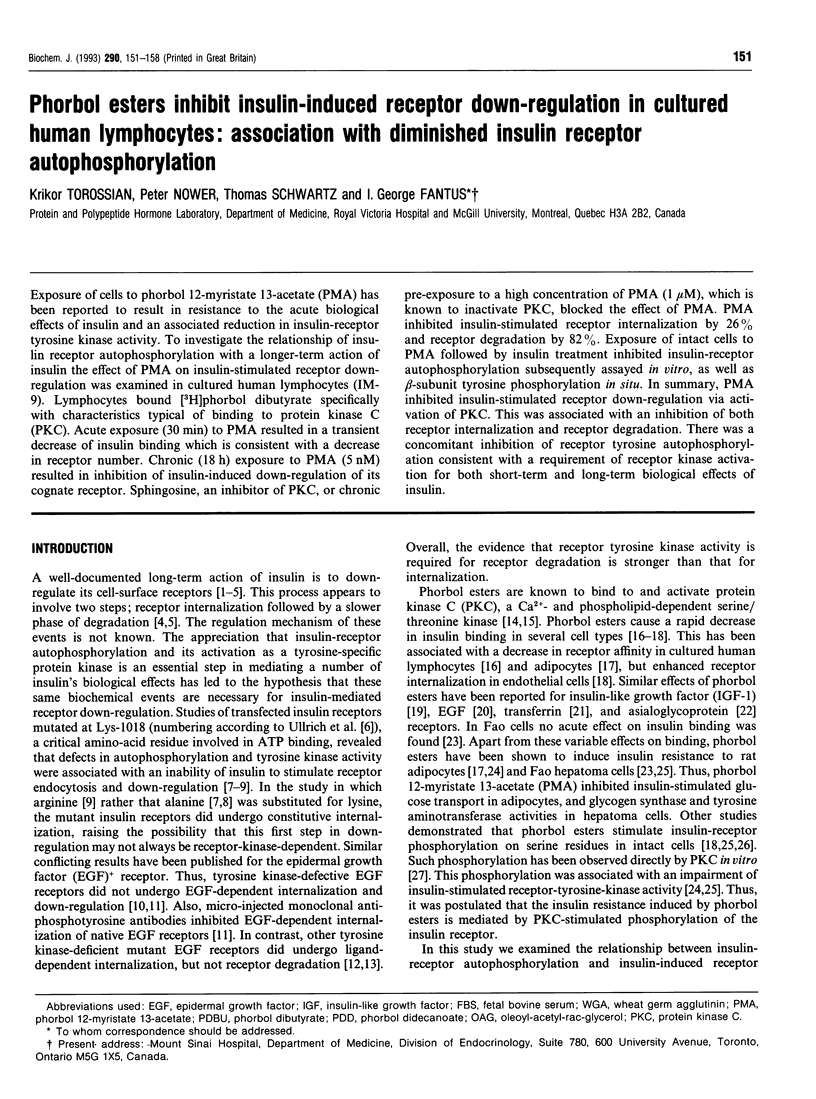
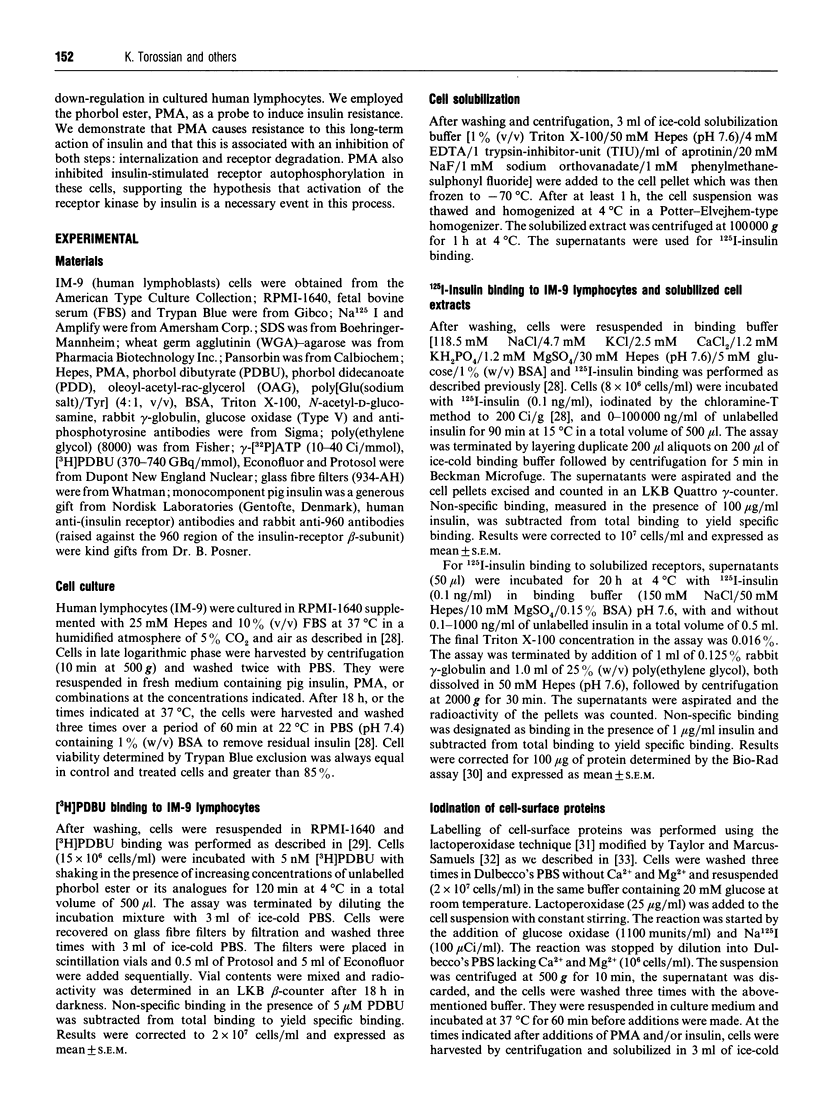
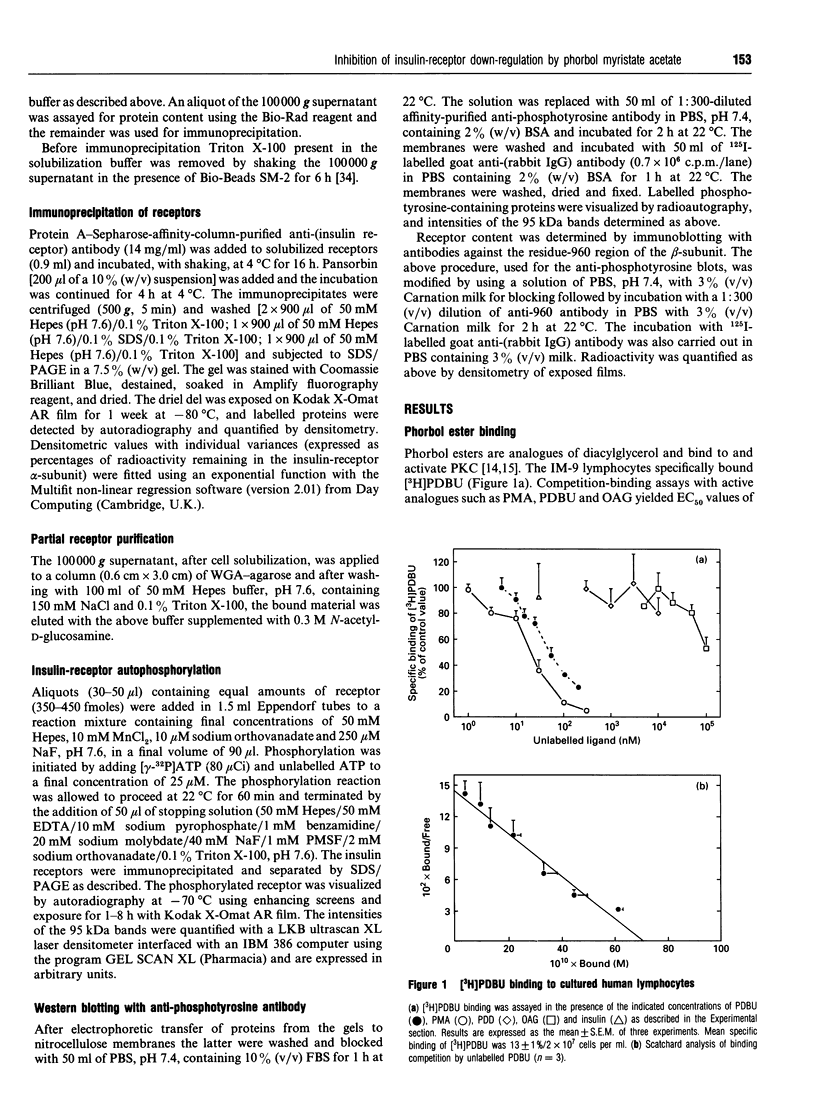
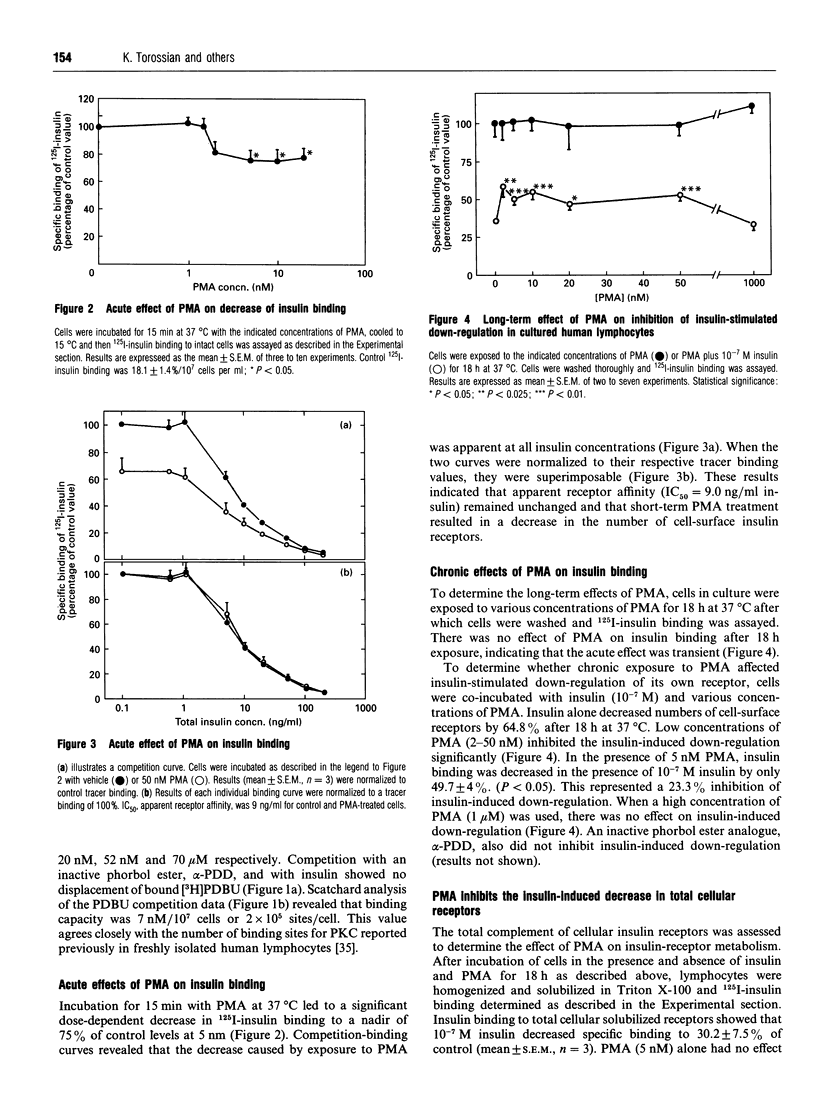
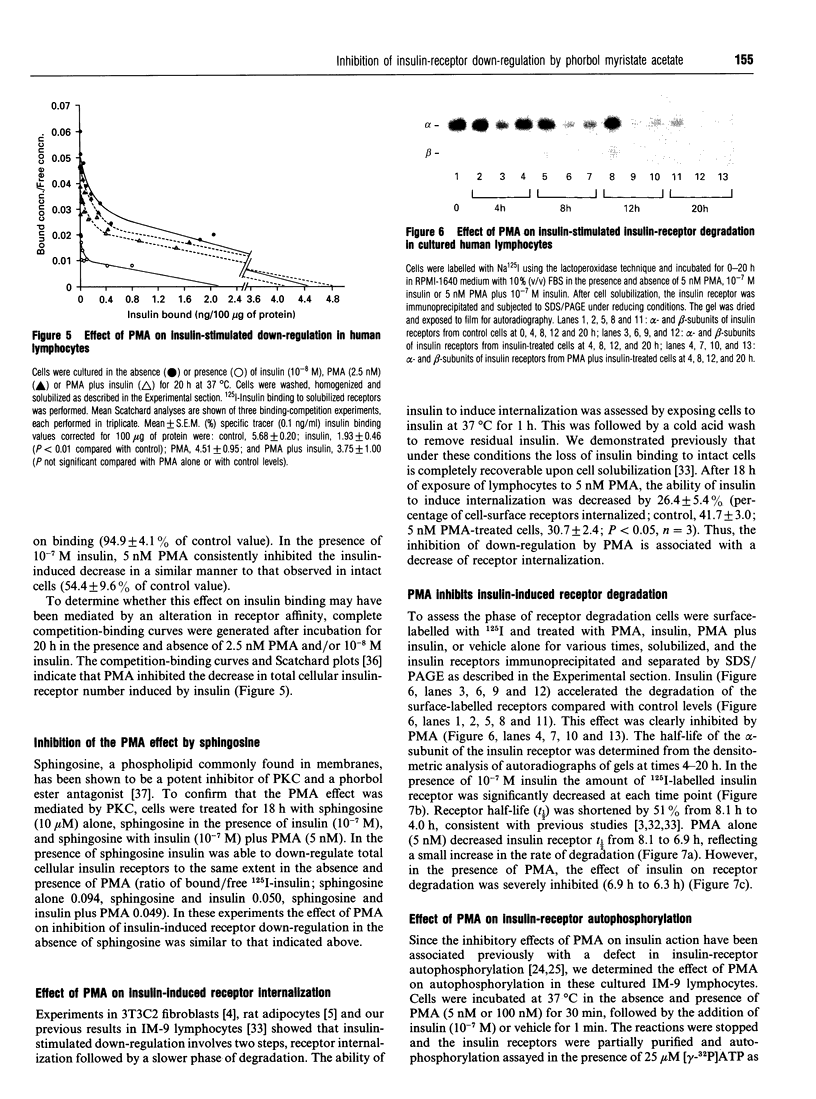
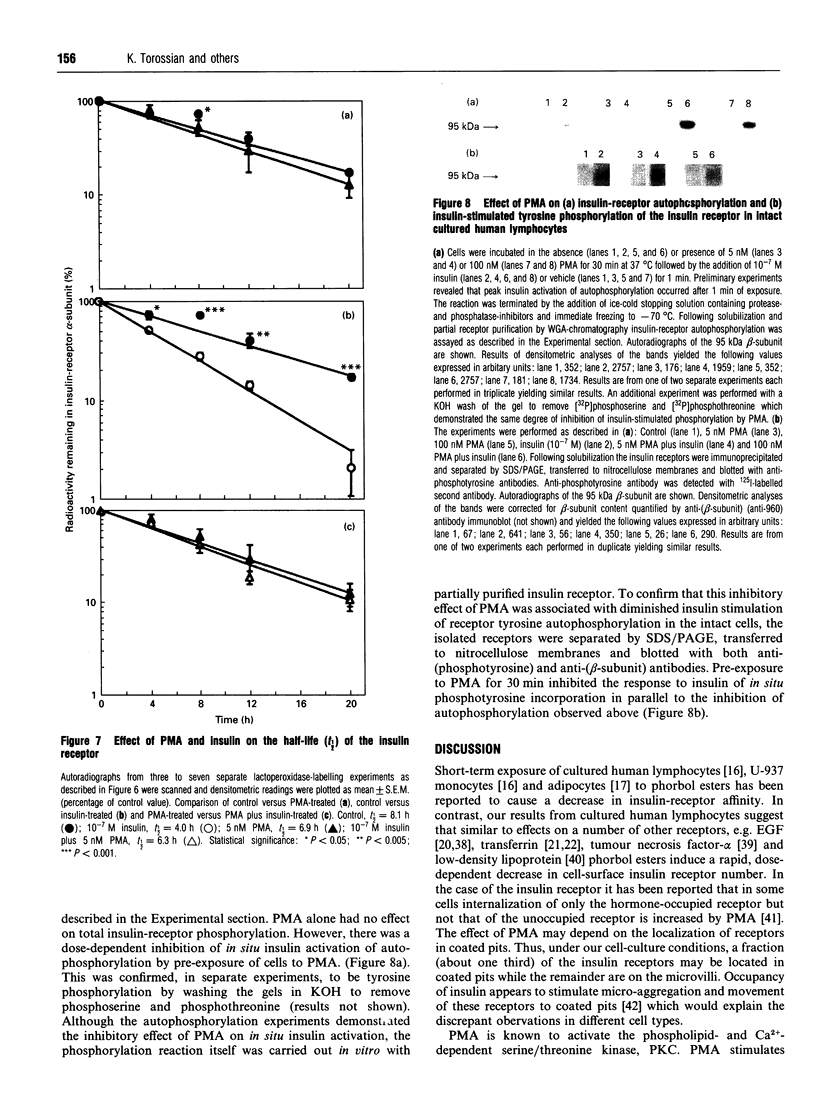
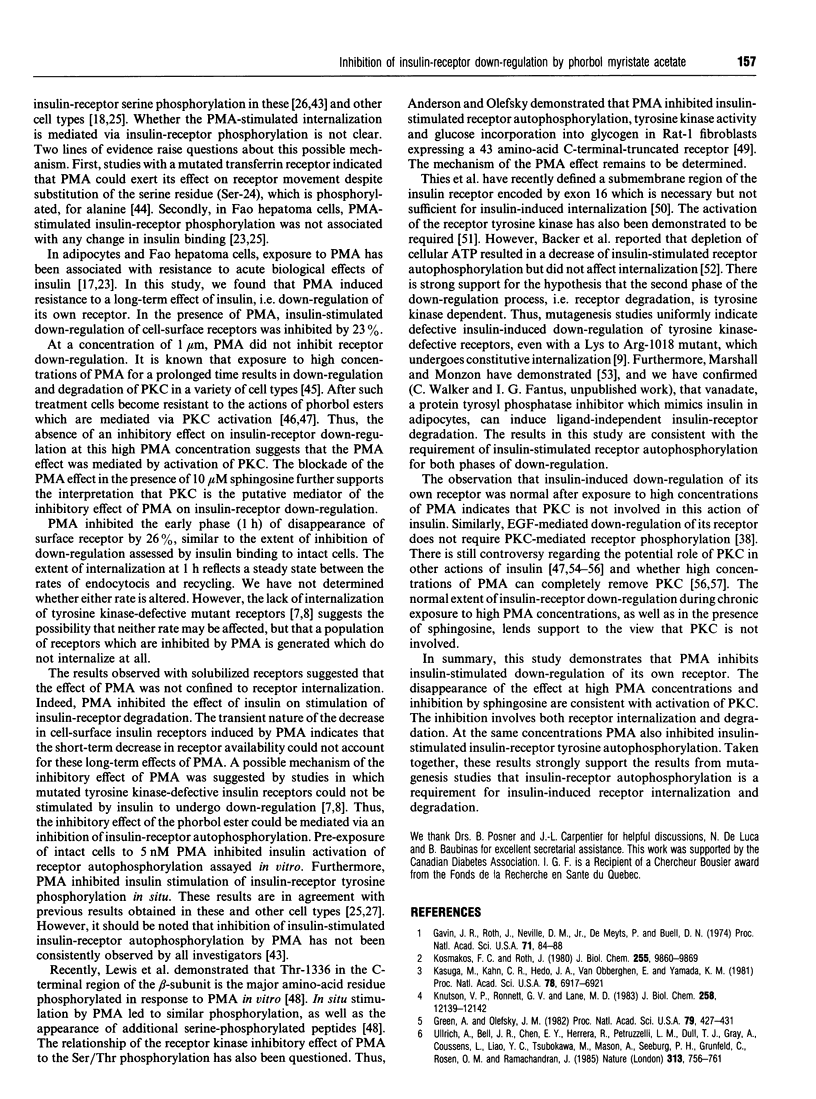
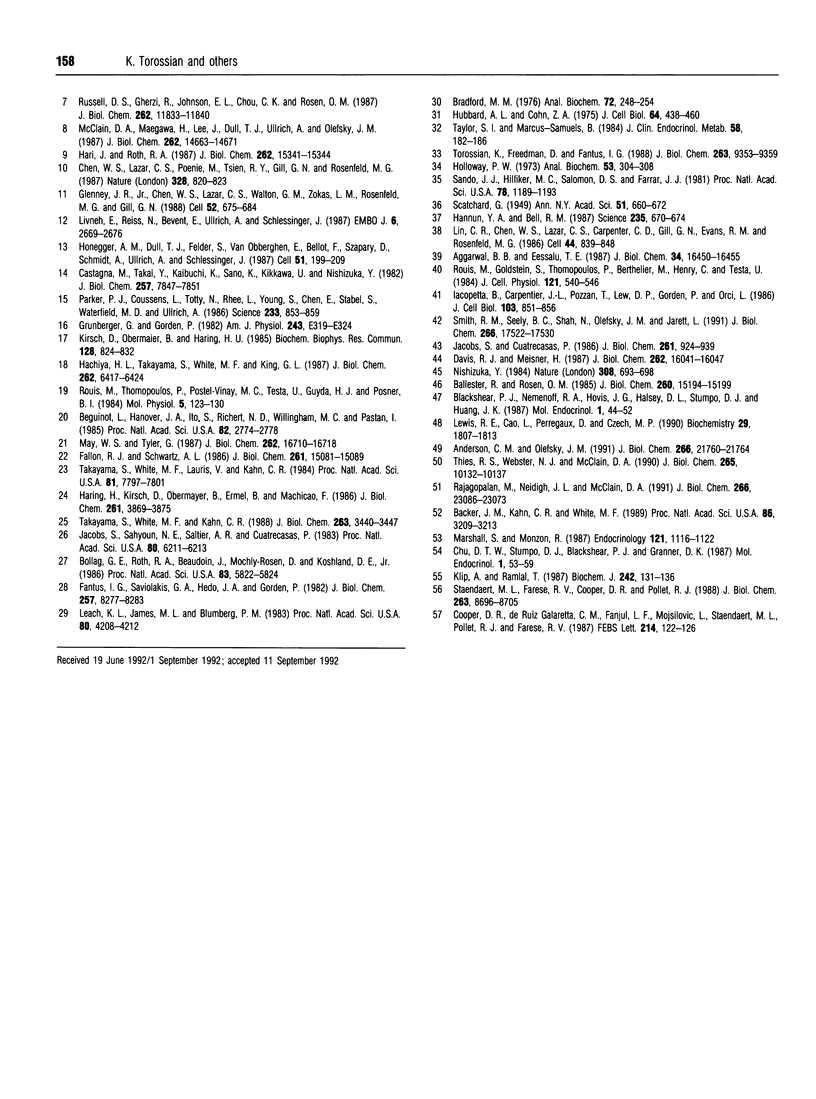
Images in this article
Selected References
These references are in PubMed. This may not be the complete list of references from this article.
- Aggarwal B. B., Eessalu T. E. Effect of phorbol esters on down-regulation and redistribution of cell surface receptors for tumor necrosis factor-alpha. J Biol Chem. 1987 Dec 5;262(34):16450–16455. [PubMed] [Google Scholar]
- Anderson C. M., Olefsky J. M. Phorbol ester-mediated protein kinase C interaction with wild-type and COOH-terminal truncated insulin receptors. J Biol Chem. 1991 Nov 15;266(32):21760–21764. [PubMed] [Google Scholar]
- Backer J. M., Kahn C. R., White M. F. Tyrosine phosphorylation of the insulin receptor is not required for receptor internalization: studies in 2,4-dinitrophenol-treated cells. Proc Natl Acad Sci U S A. 1989 May;86(9):3209–3213. doi: 10.1073/pnas.86.9.3209. [DOI] [PMC free article] [PubMed] [Google Scholar]
- Ballester R., Rosen O. M. Fate of immunoprecipitable protein kinase C in GH3 cells treated with phorbol 12-myristate 13-acetate. J Biol Chem. 1985 Dec 5;260(28):15194–15199. [PubMed] [Google Scholar]
- Beguinot L., Hanover J. A., Ito S., Richert N. D., Willingham M. C., Pastan I. Phorbol esters induce transient internalization without degradation of unoccupied epidermal growth factor receptors. Proc Natl Acad Sci U S A. 1985 May;82(9):2774–2778. doi: 10.1073/pnas.82.9.2774. [DOI] [PMC free article] [PubMed] [Google Scholar]
- Blackshear P. J., Nemenoff R. A., Hovis J. G., Halsey D. L., Stumpo D. J., Huang J. K. Insulin action in normal and protein kinase C-deficient rat hepatoma cells. Effects on protein phosphorylation, protein kinase activities, and ornithine decarboxylase activities and messenger ribonucleic acid levels. Mol Endocrinol. 1987 Jan;1(1):44–52. doi: 10.1210/mend-1-1-44. [DOI] [PubMed] [Google Scholar]
- Bollag G. E., Roth R. A., Beaudoin J., Mochly-Rosen D., Koshland D. E., Jr Protein kinase C directly phosphorylates the insulin receptor in vitro and reduces its protein-tyrosine kinase activity. Proc Natl Acad Sci U S A. 1986 Aug;83(16):5822–5824. doi: 10.1073/pnas.83.16.5822. [DOI] [PMC free article] [PubMed] [Google Scholar]
- Bradford M. M. A rapid and sensitive method for the quantitation of microgram quantities of protein utilizing the principle of protein-dye binding. Anal Biochem. 1976 May 7;72:248–254. doi: 10.1016/0003-2697(76)90527-3. [DOI] [PubMed] [Google Scholar]
- Castagna M., Takai Y., Kaibuchi K., Sano K., Kikkawa U., Nishizuka Y. Direct activation of calcium-activated, phospholipid-dependent protein kinase by tumor-promoting phorbol esters. J Biol Chem. 1982 Jul 10;257(13):7847–7851. [PubMed] [Google Scholar]
- Chen W. S., Lazar C. S., Poenie M., Tsien R. Y., Gill G. N., Rosenfeld M. G. Requirement for intrinsic protein tyrosine kinase in the immediate and late actions of the EGF receptor. 1987 Aug 27-Sep 2Nature. 328(6133):820–823. doi: 10.1038/328820a0. [DOI] [PubMed] [Google Scholar]
- Chu D. T., Stumpo D. J., Blackshear P. J., Granner D. K. The inhibition of phosphoenolpyruvate carboxykinase (guanosine triphosphate) gene expression by insulin is not mediated by protein kinase C. Mol Endocrinol. 1987 Jan;1(1):53–59. doi: 10.1210/mend-1-1-53. [DOI] [PubMed] [Google Scholar]
- Cooper D. R., de Ruiz Galaretta C. M., Fanjul L. F., Mojsilovic L., Standaert M. L., Pollet R. J., Farese R. V. Insulin but not phorbol ester treatment increases phosphorylation of vinculin by protein kinase C in BC3H-1 myocytes. FEBS Lett. 1987 Apr 6;214(1):122–126. doi: 10.1016/0014-5793(87)80025-x. [DOI] [PubMed] [Google Scholar]
- Davis R. J., Meisner H. Regulation of transferrin receptor cycling by protein kinase C is independent of receptor phosphorylation at serine 24 in Swiss 3T3 fibroblasts. J Biol Chem. 1987 Nov 25;262(33):16041–16047. [PubMed] [Google Scholar]
- Fallon R. J., Schwartz A. L. Regulation by phorbol esters of asialoglycoprotein and transferrin receptor distribution and ligand affinity in a hepatoma cell line. J Biol Chem. 1986 Nov 15;261(32):15081–15089. [PubMed] [Google Scholar]
- Fantus I. G., Saviolakis G. A., Hedo J. A., Gorden P. Mechanism of glucocorticoid-induced increase in insulin receptors of cultured human lymphocytes. J Biol Chem. 1982 Jul 25;257(14):8277–8283. [PubMed] [Google Scholar]
- Gavin J. R., 3rd, Roth J., Neville D. M., Jr, de Meyts P., Buell D. N. Insulin-dependent regulation of insulin receptor concentrations: a direct demonstration in cell culture. Proc Natl Acad Sci U S A. 1974 Jan;71(1):84–88. doi: 10.1073/pnas.71.1.84. [DOI] [PMC free article] [PubMed] [Google Scholar]
- Glenney J. R., Jr, Chen W. S., Lazar C. S., Walton G. M., Zokas L. M., Rosenfeld M. G., Gill G. N. Ligand-induced endocytosis of the EGF receptor is blocked by mutational inactivation and by microinjection of anti-phosphotyrosine antibodies. Cell. 1988 Mar 11;52(5):675–684. doi: 10.1016/0092-8674(88)90405-9. [DOI] [PubMed] [Google Scholar]
- Green A., Olefsky J. M. Evidence for insulin-induced internalization and degradation of insulin receptors in rat adipocytes. Proc Natl Acad Sci U S A. 1982 Jan;79(2):427–431. doi: 10.1073/pnas.79.2.427. [DOI] [PMC free article] [PubMed] [Google Scholar]
- Grunberger G., Gorden P. Affinity alteration of insulin receptor induced by a phorbol ester. Am J Physiol. 1982 Oct;243(4):E319–E324. doi: 10.1152/ajpendo.1982.243.4.E319. [DOI] [PubMed] [Google Scholar]
- Hachiya H. L., Takayama S., White M. F., King G. L. Regulation of insulin receptor internalization in vascular endothelial cells by insulin and phorbol ester. J Biol Chem. 1987 May 5;262(13):6417–6424. [PubMed] [Google Scholar]
- Hannun Y. A., Bell R. M. Lysosphingolipids inhibit protein kinase C: implications for the sphingolipidoses. Science. 1987 Feb 6;235(4789):670–674. doi: 10.1126/science.3101176. [DOI] [PubMed] [Google Scholar]
- Hari J., Roth R. A. Defective internalization of insulin and its receptor in cells expressing mutated insulin receptors lacking kinase activity. J Biol Chem. 1987 Nov 15;262(32):15341–15344. [PubMed] [Google Scholar]
- Holloway P. W. A simple procedure for removal of Triton X-100 from protein samples. Anal Biochem. 1973 May;53(1):304–308. doi: 10.1016/0003-2697(73)90436-3. [DOI] [PubMed] [Google Scholar]
- Honegger A. M., Dull T. J., Felder S., Van Obberghen E., Bellot F., Szapary D., Schmidt A., Ullrich A., Schlessinger J. Point mutation at the ATP binding site of EGF receptor abolishes protein-tyrosine kinase activity and alters cellular routing. Cell. 1987 Oct 23;51(2):199–209. doi: 10.1016/0092-8674(87)90147-4. [DOI] [PubMed] [Google Scholar]
- Hubbard A. L., Cohn Z. A. Externally disposed plasma membrane proteins. I. Enzymatic iodination of mouse L cells. J Cell Biol. 1975 Feb;64(2):438–460. doi: 10.1083/jcb.64.2.438. [DOI] [PMC free article] [PubMed] [Google Scholar]
- Häring H., Kirsch D., Obermaier B., Ermel B., Machicao F. Tumor-promoting phorbol esters increase the Km of the ATP-binding site of the insulin receptor kinase from rat adipocytes. J Biol Chem. 1986 Mar 15;261(8):3869–3875. [PubMed] [Google Scholar]
- Iacopetta B., Carpentier J. L., Pozzan T., Lew D. P., Gorden P., Orci L. Role of intracellular calcium and protein kinase C in the endocytosis of transferrin and insulin by HL60 cells. J Cell Biol. 1986 Sep;103(3):851–856. doi: 10.1083/jcb.103.3.851. [DOI] [PMC free article] [PubMed] [Google Scholar]
- Jacobs S., Cuatrecasas P. Phosphorylation of receptors for insulin and insulin-like growth factor I. Effects of hormones and phorbol esters. J Biol Chem. 1986 Jan 15;261(2):934–939. [PubMed] [Google Scholar]
- Jacobs S., Sahyoun N. E., Saltiel A. R., Cuatrecasas P. Phorbol esters stimulate the phosphorylation of receptors for insulin and somatomedin C. Proc Natl Acad Sci U S A. 1983 Oct;80(20):6211–6213. doi: 10.1073/pnas.80.20.6211. [DOI] [PMC free article] [PubMed] [Google Scholar]
- Kasuga M., Kahn C. R., Hedo J. A., Van Obberghen E., Yamada K. M. Insulin-induced receptor loss in cultured human lymphocytes is due to accelerated receptor degradation. Proc Natl Acad Sci U S A. 1981 Nov;78(11):6917–6921. doi: 10.1073/pnas.78.11.6917. [DOI] [PMC free article] [PubMed] [Google Scholar]
- Kirsch D., Obermaier B., Häring H. U. Phorbolesters enhance basal D-glucose transport but inhibit insulin stimulation of D-glucose transport and insulin binding in isolated rat adipocytes. Biochem Biophys Res Commun. 1985 Apr 30;128(2):824–832. doi: 10.1016/0006-291x(85)90121-4. [DOI] [PubMed] [Google Scholar]
- Klip A., Ramlal T. Protein kinase C is not required for insulin stimulation of hexose uptake in muscle cells in culture. Biochem J. 1987 Feb 15;242(1):131–136. doi: 10.1042/bj2420131. [DOI] [PMC free article] [PubMed] [Google Scholar]
- Knutson V. P., Ronnett G. V., Lane M. D. Rapid, reversible internalization of cell surface insulin receptors. Correlation with insulin-induced down-regulation. J Biol Chem. 1983 Oct 25;258(20):12139–12142. [PubMed] [Google Scholar]
- Kosmakos F. C., Roth J. Insulin-induced loss of the insulin receptor in IM-9 lymphocytes. A biological process mediated through the insulin receptor. J Biol Chem. 1980 Oct 25;255(20):9860–9869. [PubMed] [Google Scholar]
- Leach K. L., James M. L., Blumberg P. M. Characterization of a specific phorbol ester aporeceptor in mouse brain cytosol. Proc Natl Acad Sci U S A. 1983 Jul;80(14):4208–4212. doi: 10.1073/pnas.80.14.4208. [DOI] [PMC free article] [PubMed] [Google Scholar]
- Lewis R. E., Cao L., Perregaux D., Czech M. P. Threonine 1336 of the human insulin receptor is a major target for phosphorylation by protein kinase C. Biochemistry. 1990 Feb 20;29(7):1807–1813. doi: 10.1021/bi00459a020. [DOI] [PubMed] [Google Scholar]
- Lin C. R., Chen W. S., Lazar C. S., Carpenter C. D., Gill G. N., Evans R. M., Rosenfeld M. G. Protein kinase C phosphorylation at Thr 654 of the unoccupied EGF receptor and EGF binding regulate functional receptor loss by independent mechanisms. Cell. 1986 Mar 28;44(6):839–848. doi: 10.1016/0092-8674(86)90006-1. [DOI] [PubMed] [Google Scholar]
- Livneh E., Reiss N., Berent E., Ullrich A., Schlessinger J. An insertional mutant of epidermal growth factor receptor allows dissection of diverse receptor functions. EMBO J. 1987 Sep;6(9):2669–2676. doi: 10.1002/j.1460-2075.1987.tb02558.x. [DOI] [PMC free article] [PubMed] [Google Scholar]
- Marshall S., Monzon R. Down-regulation of cell surface insulin receptors in primary cultured rat adipocytes by sodium vanadate. Endocrinology. 1987 Sep;121(3):1116–1122. doi: 10.1210/endo-121-3-1116. [DOI] [PubMed] [Google Scholar]
- May W. S., Tyler G. Phosphorylation of the surface transferrin receptor stimulates receptor internalization in HL60 leukemic cells. J Biol Chem. 1987 Dec 5;262(34):16710–16718. [PubMed] [Google Scholar]
- McClain D. A., Maegawa H., Lee J., Dull T. J., Ulrich A., Olefsky J. M. A mutant insulin receptor with defective tyrosine kinase displays no biologic activity and does not undergo endocytosis. J Biol Chem. 1987 Oct 25;262(30):14663–14671. [PubMed] [Google Scholar]
- Nishizuka Y. The role of protein kinase C in cell surface signal transduction and tumour promotion. Nature. 1984 Apr 19;308(5961):693–698. doi: 10.1038/308693a0. [DOI] [PubMed] [Google Scholar]
- Parker P. J., Coussens L., Totty N., Rhee L., Young S., Chen E., Stabel S., Waterfield M. D., Ullrich A. The complete primary structure of protein kinase C--the major phorbol ester receptor. Science. 1986 Aug 22;233(4766):853–859. doi: 10.1126/science.3755547. [DOI] [PubMed] [Google Scholar]
- Rajagopalan M., Neidigh J. L., McClain D. A. Amino acid sequences Gly-Pro-Leu-Tyr and Asn-Pro-Glu-Tyr in the submembranous domain of the insulin receptor are required for normal endocytosis. J Biol Chem. 1991 Dec 5;266(34):23068–23073. [PubMed] [Google Scholar]
- Rouis M., Goldstein S., Thomopoulos P., Berthelier M., Hervy C., Testa U. Phorbol esters inhibit the binding of low-density lipoproteins (LDL) to U-937 monocytelike cells. J Cell Physiol. 1984 Dec;121(3):540–546. doi: 10.1002/jcp.1041210313. [DOI] [PubMed] [Google Scholar]
- Russell D. S., Gherzi R., Johnson E. L., Chou C. K., Rosen O. M. The protein-tyrosine kinase activity of the insulin receptor is necessary for insulin-mediated receptor down-regulation. J Biol Chem. 1987 Aug 25;262(24):11833–11840. [PubMed] [Google Scholar]
- Sando J. J., Hilfiker M. L., Salomon D. S., Farrar J. J. Specific receptors for phorbol esters in lymphoid cell populations: role in enhanced production of T-cell growth factor. Proc Natl Acad Sci U S A. 1981 Feb;78(2):1189–1193. doi: 10.1073/pnas.78.2.1189. [DOI] [PMC free article] [PubMed] [Google Scholar]
- Smith R. M., Seely B. L., Shah N., Olefsky J. M., Jarett L. Tyrosine kinase-defective insulin receptors undergo insulin-induced microaggregation but do not concentrate in coated pits. J Biol Chem. 1991 Sep 15;266(26):17522–17530. [PubMed] [Google Scholar]
- Standaert M. L., Farese R. V., Cooper D. R., Pollet R. J. Insulin-induced glycerolipid mediators and the stimulation of glucose transport in BC3H-1 myocytes. J Biol Chem. 1988 Jun 25;263(18):8696–8705. [PubMed] [Google Scholar]
- Takayama S., White M. F., Kahn C. R. Phorbol ester-induced serine phosphorylation of the insulin receptor decreases its tyrosine kinase activity. J Biol Chem. 1988 Mar 5;263(7):3440–3447. [PubMed] [Google Scholar]
- Takayama S., White M. F., Lauris V., Kahn C. R. Phorbol esters modulate insulin receptor phosphorylation and insulin action in cultured hepatoma cells. Proc Natl Acad Sci U S A. 1984 Dec;81(24):7797–7801. doi: 10.1073/pnas.81.24.7797. [DOI] [PMC free article] [PubMed] [Google Scholar]
- Taylor S. I., Marcus-Samuels B. Anti-receptor antibodies mimic the effect of insulin to down-regulate insulin receptors in cultured human lymphoblastoid (IM-9) cells. J Clin Endocrinol Metab. 1984 Jan;58(1):182–186. doi: 10.1210/jcem-58-1-182. [DOI] [PubMed] [Google Scholar]
- Thies R. S., Webster N. J., McClain D. A. A domain of the insulin receptor required for endocytosis in rat fibroblasts. J Biol Chem. 1990 Jun 15;265(17):10132–10137. [PubMed] [Google Scholar]
- Torossian K., Freedman D., Fantus I. G. Vanadate down-regulates cell surface insulin and growth hormone receptors and inhibits insulin receptor degradation in cultured human lymphocytes. J Biol Chem. 1988 Jul 5;263(19):9353–9359. [PubMed] [Google Scholar]
- Ullrich A., Bell J. R., Chen E. Y., Herrera R., Petruzzelli L. M., Dull T. J., Gray A., Coussens L., Liao Y. C., Tsubokawa M. Human insulin receptor and its relationship to the tyrosine kinase family of oncogenes. 1985 Feb 28-Mar 6Nature. 313(6005):756–761. doi: 10.1038/313756a0. [DOI] [PubMed] [Google Scholar]




